#the largest territory for a male in the area pretty massive
Explore tagged Tumblr posts
Text
The Olympic Cougar Project (a collaborative effort between feline conservation group Panthera and almost everyone tribe on the peninsula) have confirmed the death of two wild cougars. One by Port Angeles and one by Blynn. These towns are 1-2 hours away from the Cat Sanctuary.
Please please please PLEASE keep your cats indoors right now. H5N1 (HPAI, highly pathogenic avian influenza) is zoonotic to cats, and it is just as deadly for them. Additionally, if you have a way to keep your shoes away from your cat(s), or sanitize them after being out in the world (bleach footbath for example), a little biosecurity wouldn't hurt.
A sanctuary in Washington just lost 20 of their rescue big cats to this virus. It is not getting less dangerous for your cats this year than it was last.
It has ALWAYS been dangerous to let house cats free roam without supervision, but it's becoming dangerous right now to be taking them on leashes if they will have access to ground birds have recently been on, or water they have accessed. Catios might be okay, if they're covered and well-screened, but I would take a moment to subscribe to your local state ag department's email or phone alerts for HPAI in your area, and react accordingly even for covered outdoor areas.
Keep the Kitties Safe!
#the largest territory for a male in the area pretty massive#most of the eastern peninsula coast#really curious where the wild cats picked this up#I have seen domestic cats killed by cougars#and chickens#all dumped in the woods randomly
10K notes
·
View notes
Text
Wildlife of the Windswept Plateau
Hey I've decided to make this a series. Next on my list of "researcher documents the Flights native wildlife" we have the Wind Flight! I hope this is at least a good jumping off point for you writers/RPers/Worldbuilders!
Includes little personal notes here and there about possible uses, ecology and real-life equivalents, and interesting notes from the items bio too. Calling this series “Ecology of Sornieth” where I detail: Wildlife. Aquatic life. Insects. Plant life. ???.
Long post ahead. Cut for convenience.
Wild Life:
Balsas Anole (Able to change color based on mood. probably a popular catch for hatchlings) Plague Bat (Bats native to the Scarred Wasteland. Most likely purged for spreading diseases.) Sun Flecked Fieldmouse (Fur sparkles in the sunlight. can leap great distances and has a tendency to brood.) Zephyr Sparrow (Flies very high but is prone to oxygen deprivation. Tend to be short lived due to this reason. Possibly kept by dragons for it's plumage) Broad-footed Moles (Stubborn. strangely tend to dig in opposite directions from their mates. Possibly dug up as food by hatchlings) Cottontail Rabbit (A decent meal for dragons, probably farmed for meat and fur. hilariously large dragons might use them similarly to cottonballs.) Hooded Hen (Can be ornery maybe? A decent meal for a dragon. Probably farmed for meat and feathers.) Steppes Box Turtle (Known for the pattern on it's shell) Hooded Skunk (despite being a skunk its rather docile. Probably hunted for as wild game for meat and fur) False-Peacock Quail (Pretty plumage. A decent meal for a dragon. Probably hunted as wild game for meat and feathers) Mallard (A decent meal for a dragon. Probably hunted as wild game for meat and feathers. Note: Irl only male Mallards have the signature green hood.) Golden-Laced Rooster (Can reached running speeds of up to 15km an hour. Probably hunted as wild game.) Arroyo Toad (Most dragons have developed an immunity to it's skin toxin. Mirrors however are allergic.) Firebearer (A type of squirrel monkey. Has been observed spreading forest fires by carrying burning branches to new areas. Possibly done to flush out game from underbrush or usher in new growth in remote areas. Possibly a Keystone species?) Fancy Rat (Possibly kept as pets. Might even be given as gifts(for pets or to eat) during special occasions) Wallaby (Probably hunted as wild game. A decent meal for a dragon.) Pangolin (Noted for keeping lairs insect free! Might be kept around as a form of pest control. although maybe not by insectivorous dominated clans.) White-Eared Hummingbird (Yes birds do have ears!) Olive Sea Snake (VENOMOUS. Aposematic. Bright blue and orange coloration warns of it's toxicity. Named not for it's color by for it's curious love of olives. Note: Irl all species of sea snake are venomous. they are close cousins to cobras and kraits.) Grey Squirrel (Probably a common meat in stews and campfire roasts) Tree Gecko (Has great camouflage but oddly is color blind.) Magpie (Hunted for both their meat and hoards of shinies) Ferret (Probably kept as popular pets/small game hunting companions.) Sugarglider (A prime pest of Sugarmelon crops. Probably kept and bred as pets for their cuteness. Funfact: It's a possum!) Bar-headed Goose (Probably hunted as wild game or farmed for meat and feathers.) Crested Newt (Notable has a crest for mating displays) Emerald Striker (VENOMOUS. Contains it's venom in the "emeralds" on it's body. Probably not safe to eat due to the "venom pockets" throughout it's body) Silver Racoon (Named for it's love of silver ore and trinkets. Might be hunted as wild game.) Lesser Land Iguana (apparently very self confident. I take that to mean they are aware of how dangerous they are and probably have few predators. Probably hunted if there are no other options though. Most likely avoided due to average iguana temperament (That is to say violent as hell)) Bog Canary (Has an awful call. but it's plumage is pretty and might be kept as pets (Note: Picture depicts a budgerigar not a canary)) Golden Reefprince (A type of axolotl, has a golden sheen. typically given by dragons to someone they're trying to impress. Might be farmed similarly to Valentines roses and sold for holidays and anniversaries.) Black Swan (Probably kept as ornamental birds by the upperclass. Compete in elegant displays with each other. Probably over mating rights.) Juvenile Prairie Skink (The adults of this species perform excellent parental care for lizards when the hatchlings are young. (Note: Maternal care in irl skinks is highly unlikely. Note 2: Art possibly depicts a jeweled lacerta instead?)) Muskrat (A native to the Gladevines of the Viridian labryinth this rodent is commonly found in aqueducts hunting small aquatic life. Probably hunted as wild game or farmed for meat and water resistant fur.) Reedhopper (Amphibian. well camouflaged though makes a loud incessant croaking. Probably a common sound at night near fresh waterways like ponds and rivers.) Collard Lemmings (Has local folk stories that tell of them staring into your soul and knowing all your secrets.) Glowing Pocket mouse (Common prey to smaller predators. It's brightness indicates it's mood. Kept as familiars) Skycats (Common winged felines that guide dragons throughout the Windswept Plateau. Multiple sets of large ears implies excellent hearing. Normally catch the updraft of larger dragon wings for easier flight. Kept as familiars.) Bamboo Phytocat (Has developed bamboo growths on it's body for camouflage in the reeds. Ambush Predator. Large and dangerous. Possibly hunted for trophies or as rites of passage. Kept as familiars) Banded Owlcat (Silent ambush predators from both the land and the sky. Kept as familiars) Grassland Trunker (Small squat herbivores. Very docile. Often kept as pets or farmed for meat. Kept as familiars.) Lilyfowl (Birds who spend most of their time submerged in ponds and such. Can breath through it's plant-like growths! Kept as familiars.) Myosotis Fox (Fur is vibrant in color and displays many beautiful flowers. In the wild they most likely use this for camouflage. However they are kept and bred as companions. Possibly bred for color and flower variation. May even be used in shows. Popular among upper class? Kept as familiars.) Traveling Garden (Large tortoises with a variety of plant life growing amongst their shell. Maybe a Keystone species? Kept as familiars.) Heckling Hydrena (Possibly native to the Shifting Expanse. Unknown if invasive or just widespread. Most likely inhabits marshlands and other waterways. Apparently pose danger to stray hatchlings. Kept as familiars) Toxic Igueel (TOXIC. Coloration is aposematic to warn would be predators. Probably inhabits rocky coastlines and other marine environments. Leather is very useful in leatherworking as interfacing and support. Kept as familiars) Tradewinds Gull (Common seabirds. Popular for use in message transport. Most likely used by maritime trades. Kept as familiars) Blueridge Greatshell (Large aquatic turtles that inhabit freshwater only. Cannot survive saltwater. Probably hunted for meat. Kept as familiars) Scaleside Noggle (Most likely a riverway/lake predator for small to mid sized creatures. Kept as familiars) Fiendcat (Fiery predators that cook their prey. large and dangerous. Probably a threat to smaller clans. Hunting one could be considered and accomplishment. Kept as familiars) Bluetail Skira (Large herbivores who spend much of their time lounging in ponds and lakes. Blue algea growing on their tail gives it that blue color. Kept as familiars ) Ringlet Amphithere (Tiny winged snakes that can fit in a Fae's claws. Might be kept as pets. Kept as familiars.) Hippojay (Might be farmed for meat or hunted as big/trophy game. Probably a common sight in wind clan backyards. Or kept as familiars) Crowned Roc (DEADLY. Massive dangerous birds that can be found hunting the skies of the Windswept Plateau. Poses a threat to all but the largest of dragons(Imperials?). Might even hunt/eat mid to small sized dragons. Apex predator of the region and a possible keystone species. Might commonly be the subject of stories, legends, myths, art, ect. Hunting one is probably a great event. Kept as familiars) Cloud Chaser (Airborne cetaceans that fly through the air, possibly in massive beautiful pods. produces clicks and whistles. Groups of them might sound like an orchestra of woodwind instruments. Most likely the favored prey of Crowned Rocs. Also probably subjects of popular culture. Kept as familiars. )
Aquatic Life:
Fissure Crawdad (Found only in dark crevices. Tasty. worth the effort) Leech (Common pest after swimming in waterways) Common Minnow (can be eaten in mass quantities for nourishment. Possibly kept in dragon aquaria) Sun Baked Oysters Jumbo Shrimp (Meat has a sweet and tender flavor.) Pumpkinseed Sunfish (Tasty and addictive when roasted and salted. decent meal) Sea Sparrow (flying fish known for it's abrasive chirping) Sea Hare Sea Fae (Known for it's resemblance to the dragon species. Plentiful snacks) Dumpling Squid (dipped in tangy sauce when eaten) Golden Rainbow Trout (Commonly fished from riverways as a decent meal. Golden shine is noticeable from the bank. Might be farmed in aquaponics for meat) Green Corydoras catfish (Tiny bottom dwelling armored catfish. Might be kept in dragon aquaria) Golden Cushionfish (Puffer fish) Seabed Pincher (When threatened they swarm and attack the threat. Plentiful food if a little difficult) Longfin Urchinbane (Species of cardinalfish that preys on urchins. considered a pest fish by dragons.) Sea Heart (Some kinda urchin. might be preyed on by Longfin Urchinbane) Steppes Pincher (Well camouflaged and possibly territorial) Topaz Guppy (Very friendly, possibly live in a area free of natural predators. Beautiful copper finage. possibly kept in dragon aquaria) Silverside Tetras (Small tetras, shimmery scales confuse predators when in schools. Possibly kept in dragon aquaria) Red Octopus (Color changing cephalopods. Might display typical cephalopod intelligence. Tentacles might be eaten as seafood.) Lesser Shallowshark (Small cat sharks. Scavengers. Large schools are common and very efficient at striping large carcasses) Royal Oyster (The more pearls this species has produced the more valuable they are to dragon collectors.) Chromodori Swimmer (Variety of dragon sea slugs) Golden Snakehead (Labrynthian fish capable of breathing through primitive lungs. Allows them to live in low oxygenated water. Medium vicious predators. Decent meal for dragons.) Electric Stingers (Jellyfish whose sting is particularly painful) Marbled Hatchetfish (Top dwelling schooling fish. Probably kept in dragon aquaria) Kuhli Loach (Bright colors ward off potential predators. Probably kept in dragon aquaria. (Note: Water spaghetti! One of my favorite fish in aquaria)) Molten Goby (Thrives in incredibly hot waters. meat is possibly very spicy.) Glass Isopod (Have very fragile shells that crack easily.) Pale Smallmouth (CANNOT handle water touched by the plaguebringer, It's presence is an indication of a healthy ecosystem and safe water. Indicator species. Decent meal for dragons too) Discus (Popular, beautiful, and challenging to care for in irl aquaria. Possibly kept as decorative fish for the upper class in dragon aquaria) Four-Eyed Butterflyfish Morning Star (Seastars active only in the early hours of the morning.) Angelspine (Golden spines of this urchin are valued. Meat however is bland.) Gaseous Megashrimp (Big, kept as familiars. this is speculation but depending on the size it may also be used as a seafood alternative to whole roasts like pig) Skittering Megashrimp (See above) Lurefish (Predates on other fish using it's lure. Probably a species of jawfish. Kept as familiars) Plantation Pincher (Considered a rampant pest on farmland.)
Insect Life:
Gliding Ant (Known for it's ability to glide across the ice. Most likely Native to Ice) Honeybee (Tastes sweet. Most likely kept for food as well as honey.) Crop Cutter (Pests that can devour entire fields. Plant eater hate them while others feast on them.) Nymph (appears to be just a grub) Bean Beetle (considered a pest to gardener. popular to eat for insectivorous dragons though. Get your Fae friends!) Swamp Mosquito (Clouds of this insects are a joy for insect eaters and a plague for everyone else.) Blow Fly (Very common in summers. tend to swarm lairs to keep cool. Doesn't need to be stated that that's upsetting.) Cricket (Commonly caught in bulk, dried, and sold as snack. Faes are experts at catching them) Greenworm (Blends in well and challenging to find) Garden Snail Spotted Grasshopper (Particularly vibrant specimens are caught as trophies and pinned to walls by Fae.) Stick Insect (Tundras often mistake them for actual sticks and often get a buggy surprise) Striped Earwig (Common pests that get into everything) Lunar Lacewing (Swarms can be found flitting between trees on full moon nights.) Redknee Tarantula Southern Grass Cicada (Nymphs can't fly and are commonly dug up as snacks) Millipede White Cabbage Butterfly (Very common. Overconsumption can lead to gas issues.) Stinglash (DEADLY. Aposematic. Skull pattern on it’s head is a threat display. When stinger is removed however it’s considered a delicacy) Pillbug (curls into a ball when threatened) Four-Spot Mealworm (Commonly found feasting on festering rot) Rhododendron Leafhopper (Swarms of these insects inhabit the interiors of bamboo stalks. Hatchlings love playing "Shake the Stick.") Venomous Fly (DANGER. Bite has paralyzing venom.) Green June Beetle Blackshield Cockroach (Fae use rocks to crack it’s shell for eating.) Diving Aranea (Aquatic spiders similar to the diving bell spider) Petal Moth (Makes its home in flower beds of a similar color to its wings, helping it hide from darting birds and lesser mammals.) Yellowtail Caterpillar (Commonly eaten in piles with pepper sauce, cucumber, rice, and wrapped in seaweed) Bark Biter (Devours tree bark. Can devastate entire forests overnight if population wasn't kept in check by dragons. Quite tasty!) Water Bug Micromoth (Common reagent in magical remedies. Most likely cultivated for medicinal purposes) False Mantis Prickler (Herbivorous. Example of batesian mimicry. Mimics the threat display of mantids to fool predators) Autumn Pennant (Dragonfly. Scarce, only appears towards the end of autumn) Brave Blue Bee (carapace is a shiny blue color. Possibly a species of solitary bee.) Reedcleft Sparkler (Hides amongst reeds. capable of bioluminescence) Leafy Moth (This large moth feeds by spreading its chlorophyll-rich wings in a patch of sunlight and flapping gently. Large. Possibly farmed as cow equivalents to insectivorous dragons. Kept as familiars) Triple-Sight Firebug (Dragons closely bonded to this bug can use it’s sight for short periods of time. Possibly used for rough reconnaissance. Kept as familiars) Goliath Mountain Beetle (Long lifespans and natural armor allow this insect to reach enormous sizes. The largest has up to a 7m wingspan! I could see these being herded and tended to by Fae. Kept as familiars.) Garden Larail (Pests. A gardeners nemesis. However they are cannibalistic and keep their own population in check.) Highgrass Priest (A type of mantid)
Plant Life:
Clover (Common plant life. A legend tells of a rare clover that can unlock anything and uncover buried treasure.) Cliff Lion (A species similar to dandelions that grow on cliffsides. Like it's cousin it can be fermented into wines and beer) Sweet Grass (Some dragons choose to chew on sweetgrass for hours. probably similar to chewing gum.) Cindershroom (Spores resemble cinders but are completely harmless. Unknown if edible. Possible.) Red Emperor Tulip (Cultivated by herbivorous dragons as both beautiful displays and tasty treats!) Greenstripe Amaranth (Healthy food for herbivorous creatures. Cultivated for food. Naughty hatchlings pass their amaranth to their familiars.) Wild Mustard (Grows in thick patches with bright yellow flowers. Goes great with wild Catsup) Thistle (Provides food for herbivores. Seeds provide food to songbirds.) Sour Spinach (Has little to no nutritional value and is nearly inedible. Used to discipline naughty hatchlings.) Sunkernel (Smallest of the acorns. Harvested and eaten in mass quantity.) Green Shoots (Hollow. Makes for a chewy meal or a durable paper.) Chickweed (Used in herbal remedies to sooth itchy scales. Probably cultivated for medicinal purposes) Greater Plantain. (possibly like its relative the Herbal plantain whos leaves can be used as an effective anti-toxin. Probably cultivated for medicinal purposes) Peace Lily (Pretty and edible, it’s petals are a favorite snack of peace doves. Probably cultivated for decoration and consumption.) Corona Sempervivum (Edible succulent. Cultivated for food and décor) Treasure Plant (Considered to bring good luck if kept in the lair. Possibly cultivated for decoration or as gifts.) Boxwood (Has a subtle flavor?) Seaberry (Bright blue berries most likely found near marshes and waterways.) Bonebark Mold (Plentiful. grows on dead trees.) Tundra Cactus (Grows well in winter and colder climates. Probably native to Ice.) Sour Green Apple (A green apple. Sour. Probably cultivated in orchards for consumption) Wild Onion ( Edible? Possibly Deadly??) Prickly Pear (The fruit of cacti. Edible but not that great.) Peppermint (can be consumed to help aid a number of maladies such as indigestion, nausea, colds, and headaches. Probably cultivated for medicinal purposes) Sunbeam Fig (Edible fruit. Trees only produce fruit when exposed to direct sun for long periods of time.) Fairy Ears (Tree fungus. Theres a myth explaining it's existence but it's apparently unpleasant. Unknown if edible.) Green Plantain (Has a tart flavor and can be stored in cool places for long periods of time. Probably cultivated and exported to other flights.) Lume Daffodil (Blooms under moonlight, with a cool, refreshing taste. Often consumed as after-dinner mints. Probably cultivated for these reasons.) Quinoa (Recently, Tundras have started claiming quinoa is full of vitamins, cures disease, and attracts mates. Mirrors are skeptical.) Pinwheel Paddies (The blooms of this plant can spin for hours.) Minty Jadevine ( leaves are favored as snacks due to their sweet, cooling taste. Probably cultivated for these reasons.) Strawberry (Its a strawberry.) Withered Rose (perfume made from this rose remains nauseatingly strong. Dragons may use such blooms to cover up all manner of undesirable scents. Possibly cultivated for this industry) Pompom Mums (Vibrant, cheerful petals. Very attention getting to pollinators. might be used to attract pollinators to fields. Also useful for decorative purposes) Sand Creeper (Type of ivy that spreads prolifically over sand. Might be a good crop for those in barren wastelands.) Charged Duneberry (Berries glow brightest and taste the best after storms. Possibly native to the Shifting Expanse.)
???:
Gale Wolf (Dangerous and possibly extradimensional? Only appear wherever a warm front meets a cold front. leaves behind mass destruction. Hunting them is probably considered a great accomplishment. Kept as familiars) Glassbound Gustvul (Glasslike vulpines that can be found often napping in patches of sunlight. Might be popular in folk-lore, stories, art subject ect.. Kept as familiars.) River Muck (Goopy. probably common in or near waterways. Probably a pest/hazard) Garden Watcher (Walking tulips???) Orange Blotch Pansy (??? Uproots and moves itself to more optimal locations when required.) Cactus Marzal (Behaves like a normal plant until it matures in which it will become more animalistic. Weird. Kept as familiars)
#text#my writing#reference#resource#fr#flight rising#flight rising lore#wind flight#flight rising wind#fr wind#fr lore#fr headcanon#Ecology of Sornieth#next is either arcane or shadow
40 notes
·
View notes
Text
Episode 2, act 1
A reminder - you can get the full first episode here to catch up - https://www.patreon.com/posts/23638142 and the second episode is available fully for my patrons!
The apartment building across the street glared down at everyone and everything near it. The roof had caved years ago, causing the windows near the top to form furrowed brows. Each of its twenty-four ‘eyes’ gave Sheila the blame for its condition. To her, the entire area felt filled with irate buildings, vexed street signs, and the cars were downright indignant.
She didn’t blame them for their anger. In the latter part of the Crusade, when the then-governor had discovered a community of aggressive Fae in Jersey City, the Guard were sent to drive them out. The 42nd National Guard division, ironically enough known as the Rainbow Brigade, was not ready for the resistance they encountered. Everyone had heard stories about trolls and bridges, but few understood just how protective of their territory they truly were. Yearly memorials for the 113 human lives lost in what the papers called a ‘military debacle’ reminded the people just what the Folk were capable of.
Since soldiers hadn’t done the trick of routing the ‘monsters’ from such a key location (right outside the Holland tunnel), bombs were dropped next. Whoever had constructed the ‘anti-Fae’ bombs hadn’t bothered to reduce their destructive capacity. The goal was to spray a chemical mix of iron and silver in all directions; it would have been devastating enough for the Folk if they’d stopped there. Multiple ordinance explosions ensured that what would have been a slower death by iron inhalation was, instead, instantaneous.
Those who bothered to count the bodies of fallen Fae discovered 9 families, a total of 35 Folk. With millions of the Good Neighbors destroyed in similar acts of violence, the location Sheila stood on now was one of the few where human lives lost were greater than their enemies’.
She had decided to stop walking only a short time ago, instead finding a street light to lean on. The iron and silver had sunk into the ground. With every step she could feel the bone cold pain of that horrid mixture sapping her strength. She could feel it through the layers she wore; jacket, gloves, leg warmers, even the rubber ‘shoe’ wrapped around her hooves. The weather was chilly, but it wasn’t the air that made her clutch her arms to her chest.
“I would really, really like to get out of here,” she reminded Zbrozek for the third time since they had entered the city. It had been hard for her to create the portal they used, but he had insisted. “I’m not getting siderosis for you!” Her voice echoed past the furious buildings from across the street.
“Actually, siderosis is caused by inhalation of iron-oxide exposure after many years of contact,” Alois mansplained while checking the back seat of an abandoned car. “We aren’t going to get it from a short jaunt into a dusty area.”
“Well, you aren’t Folk,” Sheila pointed out, though quieter, not crossing the street to join them. She was the only one of the nonhumans the lieutenant had brought on the mission; she felt a bit outnumbered. Zbrozek had enlisted a pair of BNC commandos dressed in full riot SWAT-style gear, saying it would ensure their ‘safety.’ The satyr did not feel the least bit safer with them around.
To the north, a group of cars waiting to enter the tunnel started honking. ‘Tall soldier’ lifted his MP5 towards the noise nervously. Sheila remembered their names, and was mostly sure that one was ‘Chatfield,’ but she had nicknamed them anyway. Closer to her, ‘Box Warrior’ (what did Bohag mean, anyway?) made a cautionary noise.
“Easy, brother… area free of hostiles as of oh-eight-hundred this morning,” Boxy said, patting Talls on the shoulder. With a flick of a thumb over his shoulder, Boxy indicated Sheila, “They wouldn’t take a chance with the princess.”
“I asked them to do the sweep,” Zbrozek corrected, loudly, before the satyr could express her dissatisfaction at being referred to as a ‘princess.’ “Because we have to have noncoms with us. Stay focused, and leave the princess be.”
After closing her shocked mouth, she stomped her hoof once before looking away from the humans, chin upwards. A moment later, she smiled to herself, remembering the awed faces of the soldiers when she had opened the portal. It had taken most of her strength to bind the trod, but that moment had made it all worth it.
“We’ll do this in a grid pattern,” the lieutenant continued, making motions. “We’ll have to check all of this before we can return. The sighting was right by the Hess station there, so our intelligence is that the creature lives close by.”
Sheila walked across the street towards them at a determined gait, chill or no chill. She drew attention to some graffiti on the side of the glowering apartment building by rapping on it with her knuckles.
“They’d be in here,” she said, her face a rare combination of pride and nausea.
“Explain,” Zbrozek demanded as he moved up next to her, examining the wall.
“Most of this is street tags,” she answered, stepping away from the wall. “Some of it is quite good… see the colors in the young woman’s face up there?” A glance back at the lieutenant was all it took to get her back on focus. “Anyway, that bit there isn’t paint, it’s spit.”
The symbol in question was dayglo green, smeared like a finger painting into a rough ‘X’ shape.
“How can you tell?” the doctor inquired, reaching gloved fingers up to touch the substance.
“Smell,” she replied bluntly in an effort to close that particularly line of questioning down quickly.
“Okay, by the numbers then,” the lieutenant moved towards the door, pulling his service pistol out of his jacket holster.
“You’re going to take her word for it?” Talls said, adjusting his helmet. Sheila figured he was the youngest of the humans present. “How do you know she’s not setting us up, sending us into a trap?”
“Not that I need to explain it to you, kid,” Zbrozek growled. “But I know my people. Now, line up and let’s do this!”
It was obvious the soldier wasn’t convinced, but he fell into line regardless. They moved into the building, leaving Sheila and the doctor outside.
“Smell, you say?” Alois asked as soon as the three were out of sight. She sighed inwardly. Blunt hadn’t worked.
“Yeah.”
“I had noted that a lot of you have keener senses,” he commented, removing a pad from his satchel to scribble in. “That whole ‘I smell the blood of an Englishman’ thing. Can you actually do that, tell region or genetics through smell?”
The only answer he received was folded arms and a raised eyebrow.
“I only ask for science, of course.”
The sound of the MP5 rifles firing rapidly inside the building might have stopped her from answering, had she meant to in the first place. They stepped away from the building, looking up at the windows for any sign of their quarry. They could see the muzzle flashes moving from room to room on the third floor, followed by barely heard shouting. A sound like distant thunder responded, followed immediately by more gunfire.
Right above the two on the street a window exploded outward. A huge, dark form fell, surrounded by a storm of broken glass. With a quick kick, Sheila punted the doctor out of the way. Shards fell on her head and cut her raised arms; she escaped the largest mass by mere inches.
Like most people of the current age, Sheila had only ever seen trolls on the TV. Unable to hide at all after the protection lifted, anyone with a smart phone was soon capturing their enormity. The being that landed on its back next to her was quite definitely a troll. It was a giant of a being, ten feet tall if it was an inch standing yet having proportionately tiny eyes nearly lost under densely matted hair. Its nose, shaped like the back of a shovel, parted its long mane in the middle.
A massive hand nearly the size of Sheila’s torso pushed it upward to sit. It growled, a bear’s voice echoing from a larger throat, then shook off the glass like the same animal shaking off water. Even sitting it towered over her. She realized it had on thick furred pants, but was otherwise shirtless. Red welts were visible over a large amount of its dark bare chest and arms.
Her body shook with a desire to run, but she held her ground. His, for now she was sure he was male, tiny eyes showed a glint of intelligence.
“You are forest folk,” he rumbled, raising his arm over his eyes to block out the fading daylight as he stood. “And you are very pretty. Don’t make me harm you.”
Shots fired from the third floor above shook him a little, but he kept his gaze on her.
“They are using rubber bullets,” she pointed out as she stepped closer to him. His scent was musky, he didn’t stink. His matted hair was clean, his breaches freshly washed. “They don’t want to kill you, just move you someplace safer.”
“Safer,” he grunted, eyes blinking slowly, “For who?”
“Everyone,” she responded, taking another hesitant step towards him. Cautiously, she lifted a comparatively tiny hand up towards his chest: “I know you are great and strong, but you cannot fight bombs.”
His growl caused her to back off quickly. When his rumbling laugh reached her, she frowned up at him, “Hey now!”
“You are right to be scared,” he rumbled, taking one step to match the few she’d taken away from him, “I’m not your friend, just because we’re both monsters. You think you can blink your lamb eyes at me, and maybe I won’t make you into lamb chops?”
Sheila lifted her chin and squared her shoulders. “I’m part goat, thank you very much,” she began, much to the troll’s amusement. “You’re surrounded by iron, ash and bad memories. Why would you want to stay here?”
He wasn’t as amused by the question, frowning deeply. Pushing his hair away from his long, floppy ear, he flicked a gold earring on the tip.
“My wedding ring hasn’t melted away,” he rumbled, dropping his hand. “My wife’s body was never found. If I leave… how will she find me?”
The sudden eruption of soldiers from the building gave Sheila little time to react to the answer. When they raised their weapons, she raised her arms and stepped in front of him. Her sudden yelp at being shot in the hip by Talls made the large being behind her growl again.
“Stand down, dipshit,” Zbrozek commanded, lowering his own pistol. “She’s obviously got the situation under control.”
“No thanks to you shitheads,” she reprimanded them while rubbing her thigh. She really wanted to sit down from the pain, but she wasn’t going to give them free shots at the troll. “Lieutenant… fuck that hurts… can you come here, please?”
The soldiers didn’t really ‘stand down,’ not fully. They kept their weapons raised but at least they weren’t firing. As her boss walked towards her, Sheila gave the troll a smile, hoping to keep him calm.
“He is looking for his wife,” she started immediately as the lieutenant drew close. “Can’t we just let him go?”
Zbrozek’s gaze went up to the trolls even as he shook his head.
“After that debacle with the baobhan? You know we can’t do that, Red.” Sheila still winced at their choice of code name, but she nodded anyway. The tongue lashing all of them had received from Captain Golder still stung her pride.
“Him is right here,” the troll said, settling his weight on his heels. “I prefer you not to speak about me like I don’t have a choice.”
“What choice do you think you have?” the lieutenant demanded, stepping to Sheila’s side to square off against the giant.
“I could have broken you all in half,” he mused, tapping the tip of his nose with a meaty forefinger. “Still might.” Nervous chatter from the two soldiers by the door caught the troll’s attention.
A hoof hit the large being’s knee with a solid thud. “Stop it, doofus! You aren’t helping.” Ruefully, the troll rubbed the offended knee.
“Look, we need to get you out of this area. Urban renewal starts here on Monday, and they’ll send in a seek and destroy group to clear any Fae left.” Zbrozek tapped his ring finger on the side of his pistol, thoughtful rather than threatening. “There’s a place in the Catskills where you’ll be safe. A… sort of…”
“Do NOT say reservation,” Sheila demanded, glaring at him.
“There’s a very rich man who owns a huge amount of property,” Zbrozek explained. “He’s allowing us to house creatures like yourself there. He says you are an endangered species…”
The satyr’s face started turning red at ‘creatures like yourself,’ and became scarlet when she heard ‘endangered species.’ Curling her fingers into fists, she stomped a hoof as she prepared to dole out some ‘corrective language.’
“This creature,” the troll said quietly, before she could begin her tirade, “is named Gint. Until a handful of years ago, I was as much a man as you… or them.” He waved a hand at the soldiers, still near the door. “The glamour made us equal, to your eyes anyway. I immigrated here from Sweden at the turn of the last century, lured by the promise of a better life for my wife, and my kids. My family has maintained Ellis island proudly for the better part of a hundred years.”
Sheila turned away, dabbing at her eyes with the sleeve of her jacket.
“I found the bodies of my children before your scientists could take them away. All of their tiny bones had been broken in the blasts that killed them." He continued despite? because of? the flinch that the humans listening couldn't quite hide. "Their ears were rent from their heads. Trophies by the soldiers, I think. Their souls had seen enough, so I buried them in a place no one will ever think to look.” His sniff was loud, and full of phlegm, “Then I waited for my wife to come.”
“She hasn’t come back, has she,” Zbrozek said, finger still tapping the side of his gun. “Maybe she’s at the rese… the safe space? I know there is one other troll there. I don’t know if it is a girl troll, though…”
“Trollkoner,” Alois said, coming forward. His hands clutched his side, reminding the satyr of how she’d moved him out of the way. “Trollkoner are female trolls. Gint, you are lucky man to have such a wife, if I am to believe the lore.”
For the first time, the troll showed a hint of a smile, his mouth curling upwards. It was an impressively sized mouth, spreading from the edges of his jawbone.
“Ibsen is lucky to have me as her troll,” he said, “but I am profoundly lucky to have her as a wife.” The soldiers had started to calm and lower their weapons, but his grin set them on edge again. Gint waved a hand at them dismissively, “What if it isn’t her?”
“Then I give you my word that we will continue to look for her,” Zbrozek replied, putting his own weapon away.
“HA!” the troll slapped his belly with humor, small eyes glittering darkly. “The word of a human. Pshaw.”
“I don’t see that you have a choice but to trust me,” replied the lieutenant, motioning for the armed pair of soldiers to stand down. “You come with us, take a chance that I will continue working to find her, or you stay here and die when they level everything.”
Sheila held her breath while the giant considered things. Her fearless leader wasn’t bluffing, but there was no way Gint could know that.
“Shake my hand, and I will believe you,” he said, lowering his massive mitt. “Man to man.”
Zbrozek didn’t hesitate, placing his very small palm against the troll’s. But only a slight wince escaped when the grip was accepted; both men nodded at each other.
At the debrief a few hours later, Sheila slumped in her chair, staring upwards. The lieutenant had demanded she open one portal after another for days, and there seemed to be no end in sight. After she refused to open the one beyond the huge iron door, she'd been forced to acknowledge she could open one on any door. There were now five different doors painted with oils, ready to be open to places he felt were necessary. Then to top off the weariness, because she was on site for the encounter with the troll, she had to sit in while Golder asked too many questions and made too many insulting assumptions.
“You will receive no assistance from the BNC,” he fired off, adjusting his tie for the tenth time since he’d entered the room. She had counted, able to tell when she wasn’t looking because of the ‘uhm’ noise he made while doing so and the glint of light against the ceiling. “If you decide to look for this female creature, it will not be sanctioned.”
“I’m well aware,” Zbrozek responded, hands folded, knuckles white.
“You are a smart man, (uhm) so I know you will do the right thing here.”
“The troll was delivered to the Fae preserve by trod,” the lieutenant released his fingers, stretching them a few times before clamping them back together. “We’ve been using the portal exclusively for such movements. It cuts down on transportation costs, as well as public contact.”
A groan brought both of their attentions to the satyr, who slumped forward in her chair dramatically.
“Don’t wear out the Trodwalker, Michael,” Golder’s face pinched up in distaste. “I hear they break down (uhm). Is there anything else about the incident I need to know?”
Sheila glowered at Zbrozek through her lashes. Was he going to let her be referred to in the same context as the SUV they used? Unfortunately, she found Alois and the lieutenant exchanging a look. Not wanting to interfere with that situation, she put her head down again.
“Nothing that comes to mind, sir,” Zbrozek lied. Not entirely convinced, Golder turned his attention to Alois, eyebrow rising expectantly.
“I’m still working out a few medical questions with Nurse Brown,” the doctor said. “You can expect a full report in the morning?” The question seemed to be directed at the lieutenant, who nodded slightly.
“I’ll expect it then (uhm), and hopefully it will pair up with Michael’s report (uhm).” After a moment spent looking between the men, Golder gathered his brief case and walked out.
“Fourteen,” Sheila muttered into her arm, which she had put under her head as a pillow.
“Pardon?” Alois asked, coming closer to her.
“Nothing. Just… meh, nevermind.”
“Lieutenant,” the doctor asked, placing an unwanted hand against the satyr’s forehead, “when do you plan on giving our dear Trodwalker some time off?”
“We’re all tired, Dr. Uhl,” Zbrozek replied as Sheila swatted the hand away from her face. “We’re a small unit, and not getting much bigger after that crap in Denver. She can rest when the rest of us do.”
“Julien may be… out of touch with the modern Fae, but he was right about one thing,” Alois said, patting her on the back. He received an indignant growl from her in return. “Their magics are not endless. You can actually break them.”
“Explain it in a way that I’ll understand.”
The doctor blinked incredulously at the other man, then tapped his chin while he thought of a better way to put it.
“Ever give blood, lieutenant?” he asked, leaning back on the table, hands behind him. When the other man nodded, he continued, “Know how you feel uneasy, dizzy, so they give you a cookie and tell you to take it easy? Imagine that opening the portal is like giving blood for Miss Whitehart here. You’ve been withdrawing blood for days without even giving her a cookie.”
Sheila lifted her head fully, offering the doctor a puzzled look. His analogy was pretty spot on. The process of opening the gates was draining. She just didn’t understand how he knew what it was like.
“That right, Sheila?” Zbrozek asked, sounding more or less concerned. When she noted dolefully, he clucked his tongue. “Damn. I admit, I had no idea. I thought you were still giving me grief because I wouldn’t let you grab your conditioner.”
“Do you see this?” she replied, gripping the ends of her ratty pony tail. “Look at my ends? See all the frizz? The flyaways? This is entirely your fault!”
The lieutenant rolled his eyes and turned away from her, “Fine! Spend the rest of the day and night at your apartment. Do not get in any…”
Sheila had both hands on either side of Alois’s face before either of them realized she’d gotten up. After kissing him hard on the lips, she darted to the door. When she pulled it open, Whipple fell into the room, rolled to a chair, and sat like he’d been there the whole time.
“Hey, so… we get a night off?” he asked, playing idly with a pen like he wasn’t invested in the answer.
“For the love of Pete… fine!” Zbrozek raised his hands in exasperation. “All of you, get out of here until tomorrow. I’ll research Gint’s…” With the doctor the last one at the door, the lieutenant trailed off, “Wife.”
After cleaning up the cups on the table, filing the paperwork, and heading to his office, Michael sat looking at his door. He chuckled, opening his laptop.
“I didn’t even get a kiss.” An odd smile tilted his lips when he kissed his ring finger before getting to work.
Sheila smiled her own secret smile, watching her boss from the door to the bathroom. Every time she caught him doing something ‘normal,’ it caught her off guard. She thought she could almost like the man. After dramatically blowing him a kiss he’d never catch, she bounded towards her night off.
1 note
·
View note
Text
while i’m on animal stories, here’s one i’ve told before, though most of my current followers are mutuals from my old blog and have probably read it at some point over the years. this is the story of a cat who’s a goddamn hero, and a bit of insight into how domestic cats are actually pack animals too, and some personal history of my own upbringing. tw animal death at the end, though he died a GODDAMN hero and i want his legacy to be remembered.
i grew up a cat person in a family of cat people, and when you live in a mostly-rural area like we did, that means you tend to sort of...collect cats. you feed them outside, cats gather, feral cats learn to domesticate themselves over time with effort, people dump cats and kittens at your doorstep. a bunch of outdoor cats together start making kittens, and in a quick span of time a full-on pack is formed, complete with hierarchies, group parenting, personalities clashing or being in love, like gotdamn lions on the savannah. i used to just sit on the porch and watch like a little wildlife researcher, usually covered myself in kittens and young cats, as most of our queens (and most of our cats in general) adored me and considered me one of their own, gentle and benevolent.
came along one day a new tom to fill a recently-vacated void in the hierarchy, as happens. a large, long-haired strong gray tabby, chock full of good genes and new additions to the gene pool (also kitty lice, which is so rare the vet had to take down a few reference books to identify what it was, but which we eventually irradicated). My mom named him Graybeard, both because he was gray and because despite being probably only four or five, he seemed like an old soul, wise, sweet, and gentle, apparently not a fully domesticated escaped housecat but still very tame, fully willing to accept pets and scritches, and very good to our existing cats. our old top tom, Hercules, had recently passed away after a long and full life with many, many children, although he was always in love the most with our most un-catchable-to-get-fixed but beautiful queen, Smokey, more commonly known as Bitchface (i have never seen a single human being with as much bitchface as Bitchface, though she mellowed out in her old age after he passed). He would babysit her kittens when she went out in the fields to hunt, and even though he was fully domesticated (indeed, born in my closet of my first cat and named and cuddled by me since the day he was born) would be way more protective of them against human interference than any other litter of kittens, like he knew that’s what she would have wanted, and maybe he did. Hercules was like an old boxer by the very end, cauliflower-eared and a bit brain-damaged from all the brawling he did to keep predatory stray males away from his girls. He was a sweet cat when not fighting, and utterly committed to his girl Bitchface, but all lives have an end, and this is not his story
you see, in the setting of this story, it was a time between birthing seasons, as graybeard had established himself as the new sweet top tom. he didn’t bully any of the other boy cats, he didn’t torment the kittens but rather took care of them even when they obviously weren’t his, he took benevolent care of everybody. most of the cats in the pack at this point were queens or young fixed boys or girls or older kittens we hadn’t yet been able to give away or find homes for. david, the largest and best fighting cat of the family and also fixed and pretty aloof from the other cats’ forever ongoing drama, was chilling by himself on the other end of the property, so he wouldn’t be any help - when the forever baying hunting hounds from a few houses down got loose of their cage and went on a fucking rampage.
i know i was saying you should appreciate maligned dogs like pitbulls. but honestly, some dog breeds should be *MORE* maligned. like german shepherds, or hunting hounds. those four dogs got loose of their enclosure and went into heat-seeking mode for any mammal to hunt smaller than themselves, and that included our cats. most of the cats scattered to climb up trees or poles or walls, but as established, not all of them were old enough to know how to get out of danger fast enough, or some were too far away from climbing to safety. so graybeard sacrificed himself in a blatant snarling attention-attracting display to buy all the cats of his pack time, in what if he was a human, would probably be with a gritted teeth badass “one against four? i like those odds!”
our renter eventually heard the noise and chased off the four dogs, all of whom were facially savaged, from this one cat who’d bought all the other cats time to climb to safety or hide from these murderous hounds. he was exhausted and had massive internal and external wounds. but between 20ish cats and four savage mindless hunting hounds, with his martyring of himself, he’d successfully made enough of a hurricane of savagery that they’d focused on him, and every other cat in the pack had escaped unscathed. this cat, this gentle alpha pack cat, quite intentionally sacrificed himself to buy his pack time to get to safety. if you don’t think cats care, fuck you.
this is going into tw animal death territory, but he lasted a week after that. we made him a sickbed on the bottom shelf of a bookshelf in the shop that i sat with him the whole week until he eventually passed away, and his ladies would come and lay against and purr with him. his internal injuries were too much to be fixed, but he died surrounded by love. and he died a goddamn hero. never let ANYONE tell you cats don’t care about the people/cats they love. graybeard literally died for his loved ones. he’s a goddamn hero of an animal.
1 note
·
View note
Text
A brief survival guide to the mania forest
Chapter one: the hanging tree
I'm a park ranger covering a large bit of woodland in rural Russia near a town where only populated by scientists on behalf of the organization I work for. They study strange things found in the world. You've probably never heard of the woodland nor the organization as both of them are put under wraps by the organization itself but that's a story for a different time. So I will make a large amount of these posts to give advice if you find your in the woods.
Now you may be wondering what the hanging tree is. Well it isn't hard to miss as it is the largest tree in the forest, the wood is much darker than the rest of the rest of the trees, not to mention the gallow attached to the base of the tree. Now if you end up seeing this tree whatever you do never disturb it. Don't touch it, don't even pluck a leaf from a branch.
If you do, hell has no worse than what you have in store for the next few hours of your life. For around an hour after nothing much should happen, for the next hour after that a boy should start appearing in the corner of your eye, you will know he is there but you won't be able to see him directly. The "fun" will start during the third hour. You will start to hear distant screams of pain but you will never be able to pinpoint the direction. Over the course of 3 more hours the screams will come closer and closer until they become nearly deafening.
Then an hour after that (7th hour for those not paying attention) the screams will stop and not even the birds in the trees will make a noise. Then the visions start. For 2 hour you will see people you've wronged in your life in your eyes. All of which will circle you and start laughing.
The worse the crimes the louder and more demonic the laughter. Then after 2 hours the visions will part and drag you to the gallows. After your head is wrapped in the rope. Well you can make that assumption on your own to what happens after that. There is one more strange thing.
Only the people that touched the tree see and hear the trees demonic doings. Too others your going insane for no good reason. When the visions drag you to the gallows, the only thing that others will see is you walking toward the tree. Putting your head through the rope. And jumping off the platform. With how many people this tree has killed, it may be the powersource to all the strange animals, happenings and items found in the forest. How this happens. Well that isn't my job to determine. That job goes to the men, women and creatures at the organization.
Happy travels my friends. Sleep well.
Chapter two: the unknown
Among the terrible objects and creatures of the mania forest there is the unknown. No one quite knows what it is. I'm not even sure what it is. While wandering the forest there is a clearing. This clearing is different then most other parts of the forest. All the grass in this clearing is dead. As soon as you walk in the clearing you will have a strong feeling to walk toward the middle.
Oh yeah, I forgot to say. There is a small stone pillar with a button on it. While walking toward the pillar loud music will start to play. Of course like most things in this fucking forest, it messes with your mind first. Though most of the other stuff in the forest does it for torturous glee but in this, things seem to use people's emotions as food. Though I'm getting ahead of myself. While walking to the pillar, music, bla bla bla, but the music played is that which reminds the person of their worst memory. For instance we had a test subject say that they witnessed a woman being drugged at a rock concert and did nothing about it. Now he said the music that starter was the song that was playing at the time he witnessed the drugging. As you get to the halfway point you will start to smell the place your memory takes place in. The man who witnessed the drugging said he started to smell sweat and whiskey. The exact same smell the rock show had that night. And finally when you reach the pillar, well you go, catatonic. The subject spoke that he saw the image. Over and over again. And he "woke up" so to say when one of our staff found him. There is nothing visibly dangerous about the clearing. Just make sure you have someone to wake you up. There have been cases where people have died of dehydration, or have been eaten by animals while catatonic.
Happy travels my friends. Sleep well.
A brief survival guide to the mania forest- chapter 3, the fungi forest
Well, There are a very large number of creatures in this forest, from fearsome predators, to meek prey praying that they can make it out of this hell hole. Well, this is not a creature, an item, nor a building, but instead a place. Me and the other rangers can this place the fungi forest. While it sounds like a subsection of the forest, yet no, it's a cave full of mushrooms. Well actually it's a little more than just that. Well there is nothing supernatural about the caves. We were told that an asteroid containing life hit earth and made a cave which millions of years later is now a massive cavern which is full of life. I may make a whole different survival guide only for the forest as it is gargantuan in size, so big that it has its own ocean, which also might need its own guide. I just wanted to mention it here so if i make a separate guide for it the guide will give it some context. Though I will give you one thing. Somewhere in what we call the shroom ocean. There is a thing we call the saw tooth. It is an unbelievably massive creature that feeds on the mushrooms in water. Now you may ask why, well the mushrooms are about 5 meters tall each. So just a few is enough to satisfy the massive creature. It also gets its name from the awful noise it makes. The beast sounds like a heavily distorted saw.. And if you hear a large saw rapidly approaching. Well, pray to every god you know. You’ll need it
Happy travels my friends. Sleep well.
A brief survival guide to the mania forest. Chapter 4, the man with the mask
After a while, you start to get used to the forest. I mean once you learn about everything and how not to die, the job gets pretty easy. well , except for a few of the “things”. A few of the creatures of the woods can be described as `unpredictable”. While most things on the land are quite territory oriented, as in the stay mostly in the same area until provoked. There are others who wander, some whose methods or objectives are unknown. One of these minorities is something which we rangers call the man in the mask. It appears to be a african american male wearing attire which would fit a american soldier in World War two. But he's a modern gas mask. As creatures go “he” (for lack of a better word) is fairly new. Being that his first recorded appearance was in the late 80’s which coinsided with the murder of a world war two vetern which while not taking place in the woods but his body was hidden there. Also his killer was found later and was killed by the hanging tree when the cop found him. But anyway, his abilities.
It was found when the man travels a cloud of toxic gas follows. The gas is invisible and is nearly impossible to detect. The gas was found to be a match for a gas the Germans tested on american prisoners in WW2 but never got used in war. One of the prisoners who was tested was, well you can most likely guess that. Anyway, the gas itself seems to be acidic in nature. Only a few minutes after being exposed to it, your flesh will start to burn and after that your skin will well, start to melt off, But not always. There have been many cases of the man pulling out a gun and shooting someone, cases of the man strangling people, or just him leaving them alone. All of which have no pattern and are impossible to predict.
There have been attempts to kill the man, but all are unable to leave a scratch on him. A soldier once took a 50 caliber rifle into the woods and shot the man in the face. It left a massive hole in the man's head. But the hole filled itself back in. It was that day that the rangers found out, That it was not a mask on the man's face. But the gas mask is his face.so if you wander the forest and you see a man wearing a gas mask, run, there is a small chance you might make it out alive, it's always good to try
Happy travels my friends.sleep well
A brief survival guide to the mania forest. Chapter 5, the scorched king
There are things in the forest known as kings in the forest. In fact they are vital to the sorting system of things in the forest. These kings are normally some sort of animal, and they have territory in the forest, what makes them kings is that one, they are apex predators, two they have only one section of forest, and three they are so powerful that they can’t be killed with anything short of a nuke. This territory split the forest up into sections. Today I will be talking about one of the more notable kings. The scorched king, actually the scorched king is a species in the part of the forest known as the scorch. The name of the creatures is actually lava wolves, as they are wolves that have flaming fur. There is one wolf in particular that gets the title.
This wolf is one that is about the size of a full grown buffalo. Differently than the other wolves the king has a white fire while the other wolves have red fire. The scorched king earned its title after the fire on its body was found to be so hot that anything that touched, either turned to ash or melted. Making it impossible to kill it with any weapon we have now.
LISTEN I HAVE TO WARN YOU. SOMETHING IS TAKING OVER THIS FOREST. THE CREATURES ARE GOING…
End of message
A brief survival guide to the mania forest. Chapter “final”, the hive mind
Hello people of this great internet. How are we today? Now I must apologize if you were enjoying these chapters. That idiot was ruining everything. Now I must warn you very briefly (pun very intended) there are more than just the “mania forest” as you humans call it. These places are known as hell holes. And they are very abundant. Using my influence I will let you know of all of them. But not to much of their creatures. We can’t have all out chaos if you know everything now can we. okay fine i will give you a brief description of myself, so when the world ends YOU KNOW WHAT TO SCREAM AT. I am a disease. My victims have blood red eyes, and mostly are catatonic. I can switch between forms but only one at a time. And I transmit via bite, so don’t get bit. Disease in the body of Richard H. Cooper. Signing off
Travel poorly. Sweet nightmares my sheep
0 notes
Text
Australian Wildlife
One thing everyone knows about Australia is that it’s home to some of the most interesting wildlife you’ll ever see. From cuddly and cute to absolutely terrifying, the animals of Australia are certainly fascinating and unique! It’s one of the very few countries where you’ll find marsupials and egg laying mammals! There are obviously loads of animals in Australia and too many to mention them all, but it is always interesting to list up a few.
What is a marsupial? Marsupials are ‘pouched’ animals meaning that they carry their young in a pouch. Examples include kangaroos, wallabies, possums and wombats.
Egg laying mammals are incredibly rare in the animal world, in fact Australia and New Guinea are the only places in the world where you’ll find the platypus and the echidna (the only egg laying mammals that exist).
Bandicoot
There are 20 species of bandicoot. They’re endemic to Australia and they’re marsupials which are nocturnal and also omnivores (they eat both meat and plants). They’re also pretty cute.
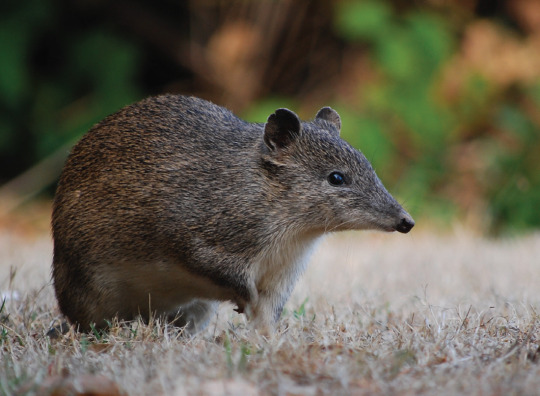
Bilby
There were 2 species of bilby. The lesser bilby is sadly extinct but the greater bilby can still be found in Australia, although it is endangered. Also known as a rabbit bandicoot, because it’s very similar to the bandicoot but with very long ears, the bilby is native to Australia.
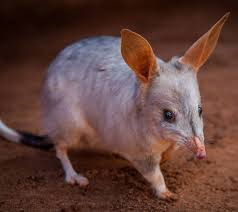
Brolga
The Brolga used to be known as the “Native Australian Crane”. As well as being the largest flying bird in Australia it’s also known for it’s mating dance. You can find Brolga’s in many parts of tropical Australia, especially Queensland. In fact it’s the official bird emblem of Queensland.
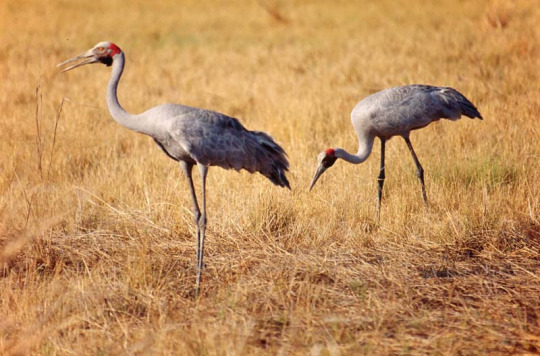
Cassowary
A terrifying looking bird in many ways but also quite beautiful because of the colours on its head and neck. You can find the cassowary in Northern Queensland although they’re relatively shy so you might not spot one. Just be aware that even though they’re shy if you do come across one they’re dangerous!
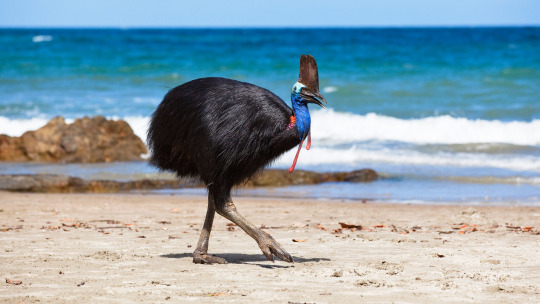
Crocodile
The saltie! Saltwater crocodiles are pretty common in waterways in Australia, especially in the north. If you see warning signs telling you to stay out of the water then stay out of the water! Although salties are pretty massive they manage to hide quite well in the water and they’re quick so you won’t fare well against one.
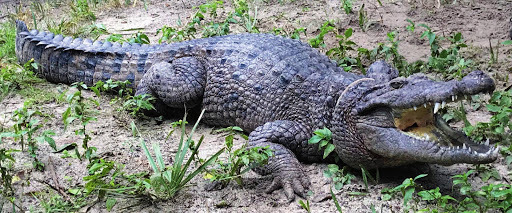
Dingo
Well you’ll have heard of the dingo which, although endangered, can be easily seen on Fraser Island.
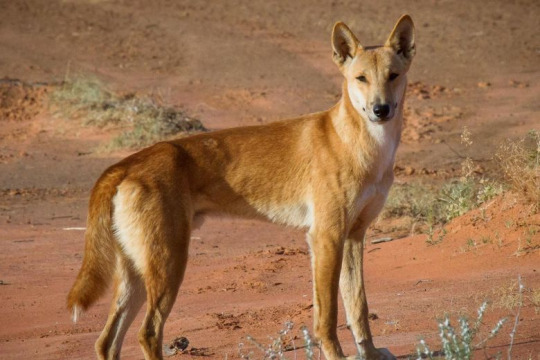
Dugong
Dugongs are similar to manatees in appearance and the only marine mammal which is a herbivore (eats only plants). Dugongs are threatened with extinction so if you do see one you’re very lucky. You’re more likely to see them in Shark Bay in WA or in Queensland. Dugongs are also known as sea cows or the “Lady of The Sea” and are thought to be the inspiration behind tales of mermaids.
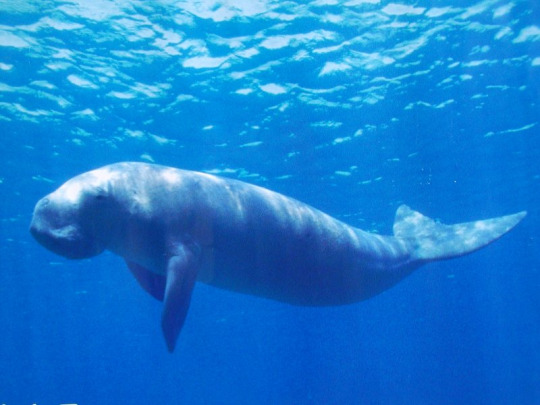
Echidna
Echidna’s really are one of the oddest animals of Australia. One of only 2 egg laying mammals that exist in the whole world, it looks a lot like a porcupine but is more closely related to a platypus. After laying a single egg 22 days after mating, the female echidna deposits the egg directly into her pouch where it remains for up to 2 months. Baby echidnas are called puggles which is just the best name for a baby animal!
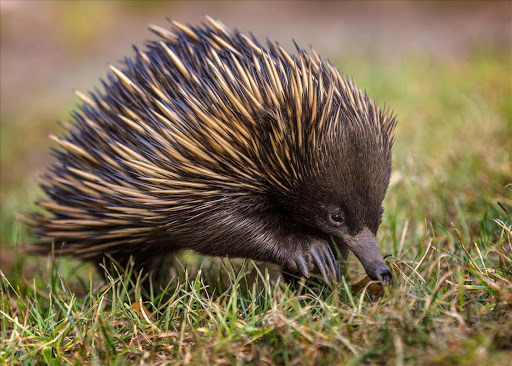
Emu
Large, terrifying up close and flightless, emu’s are not one of the most popular animals of Australia. Surprising then that they appear on the Australian Coat of Arms alongside the kangaroo. Possibly even more surprising is that they were allowed to remain on the Coat of Arms after they beat the Australian army in the unbelievable, but very real, Great Emu War. Emu’s are endemic to Australia and are it’s largest bird.
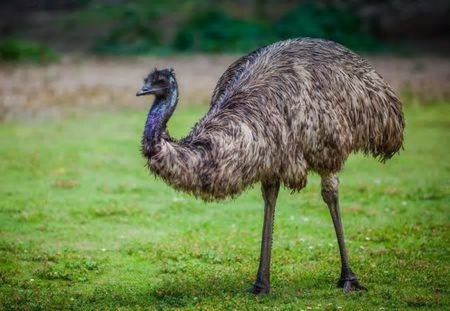
Frill Necked Lizard
Frill necked lizards are fairly hard to spot as their colours help them to stay camouflaged, except when they display their colourful frills of course. These lizards are relatively large but harmless and if you keep your eyes open you might spot one in the northern territories.
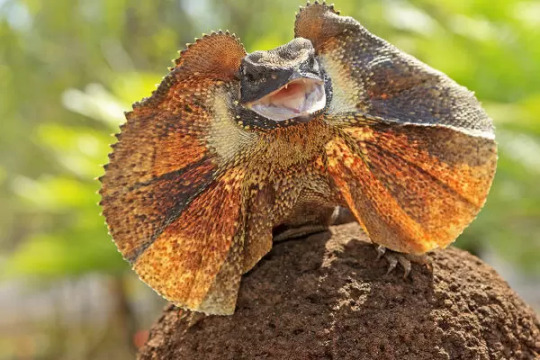
Giant Clam
If you plan on doing some underwater exploration of the Great Barrier Reef during your trip to Australia then you’re quite likely to come across a giant clam or two. Giant clams can weigh up to a whopping 200kg and can live for 100 years. They start their lives male but become hermaphrodites (can produce both sperm and eggs).
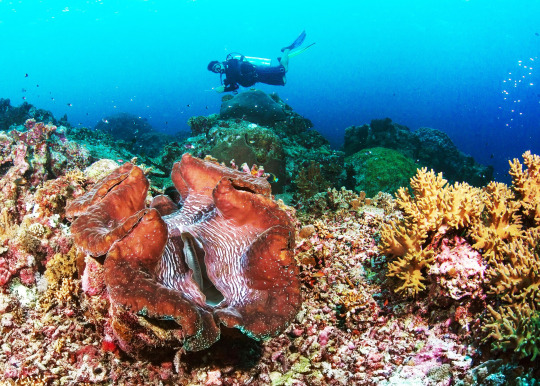
Goanna
A Goanna is a type of monitor lizard which varies in size from just 20cm long to 2 metres! Depending on what source you use there are thought to be either 20 or 30 species of monitor lizard, 15 or 25 of which can be found in Australia.
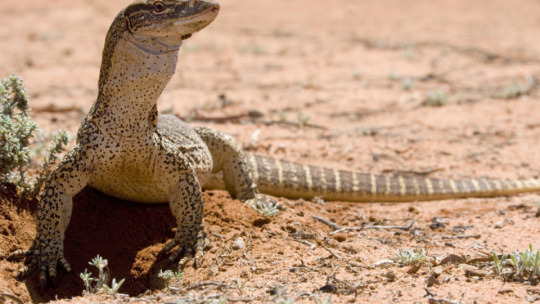
Great White Shark
Yes, they’re scary and yes they can be deadly but the majority of the time they’re not going to bother you. The Jaws films have a lot to answer for with regard to this animals reputation. They can grow up to 6 metres long.
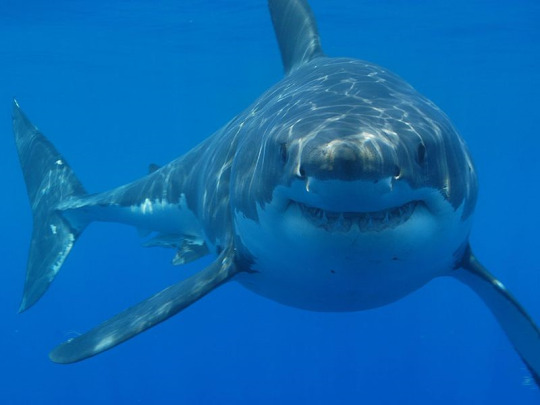
Kangaroo
Alongside the koala, kangaroos are probably the most well known of all the animals of Australia. The red kangaroo is the largest while the grey kangaroo is the one you’re likely to see most often. Appearing on the Coat of Arms beside the emu, the kangaroo is also a popular Aussie food.
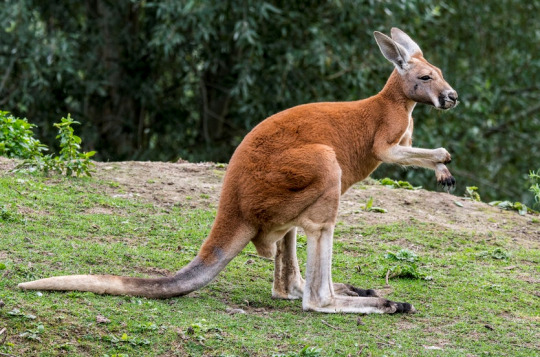
Wallaby
Wallabies are in fact kangaroos but wallaby is the informal name for those that are smaller than the kangaroos mentioned earlier.
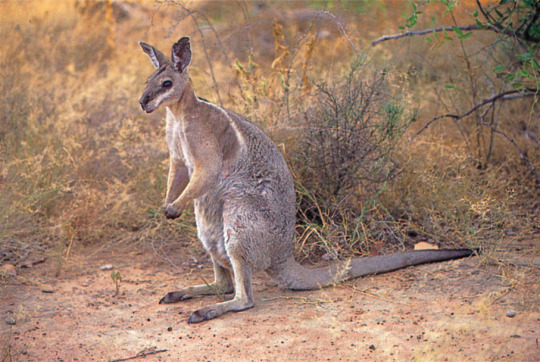
Wallaroo
Like the wallaby a wallaroo is also in the same family as kangaroos. A wallaroo tends to be larger than a wallaby but smaller than a kangaroo.
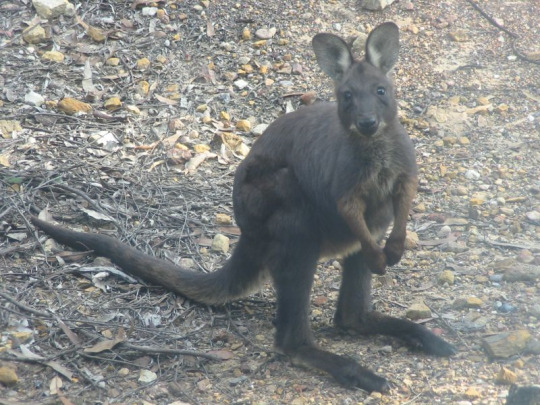
Koala
Looks like a teddy bear but is NOT a bear, don’t even think of referring to them as koala bears near Australians!! Koala’s are fairly common in coastal areas in the south and east of the country but their habitats are being threatened by humans. Koala’s in the north tend to be smaller than their southern counterparts which can be up to twice as heavy.
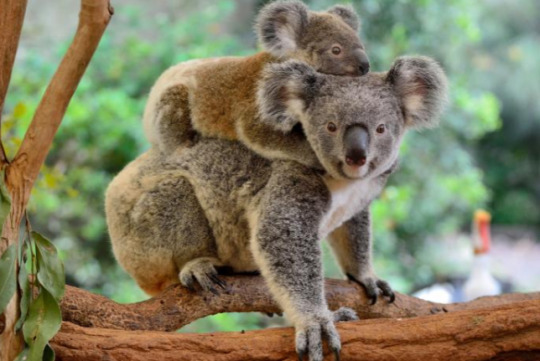
Numbat
I don’t know why more people haven’t heard of the numbat. They’re native Australian animals (to Western Australia), marsupials and really quite odd looking creatures, although very cute. The numbat resembles an anteater and is in fact known as the banded anteater. They’re endangered due to introduced predators such as cats and foxes so they’re not commonly seen.
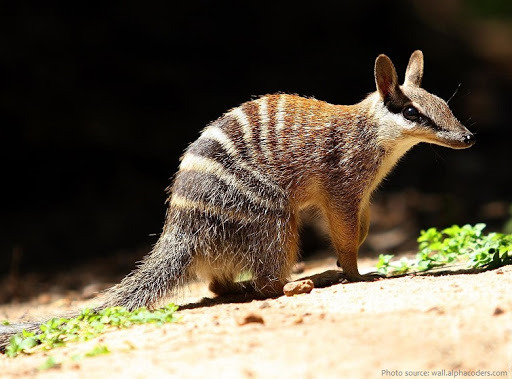
Quoll
Here’s another one of the native Australian animals that I’m surprised more people haven’t heard of because they’re so cute looking. Quoll’s are native to mainland Australia, Tasmania and New Guinea. They spend most of their day in a den and hunt at night. Quoll’s are sadly in decline due to urbanisation and introduced predators. They’re related to the now extinct Thylacine (Tasmanian Tiger).
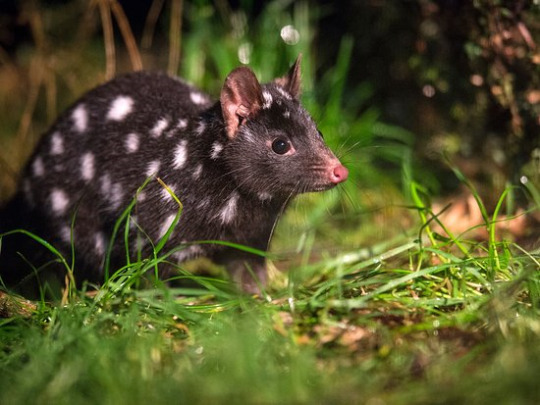
Snakes
Snakes are fairly common in Australia and no doubt you’ll be aware that Australia has loads of deadly ones! There are about 140 snake species found in Australia, 32 of which are sea snakes. And about 100 Australian snakes are venomous.
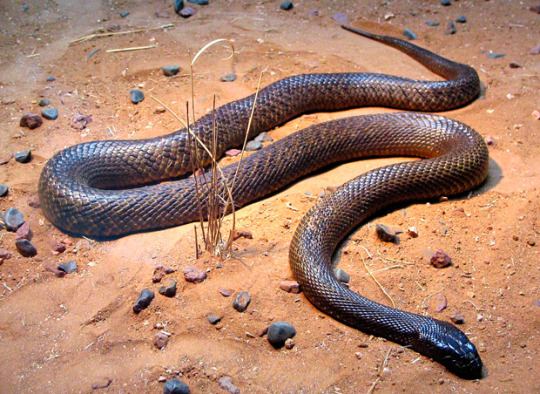
Spiders
Ok, I’ll admit it, I’m terrified of spiders but in Australia you will see them, from the massive huntsman which moves disturbingly quickly to the bright red bottom of the redback spider. As you’ll be aware some Aussie spiders can be deadly, but most won’t bother you and even if you are bitten it’s unlikely you’ll die. I am terribly afraid of spiders, that is the reason there is no photo of them on here. Plus there are many horror pictures of spiders in Australia on the internet.
Tasmanian Devil
You look at the cute face of the Tasmanian devil and wonder how on earth it got its name but they’re notorious for their bad temper when they’re defending food, trying to find a mate or when a predator approaches. This carnivorous marsupial is endangered and its population is still decreasing. Sadly they’re suffering with a facial cancer that is contagious.
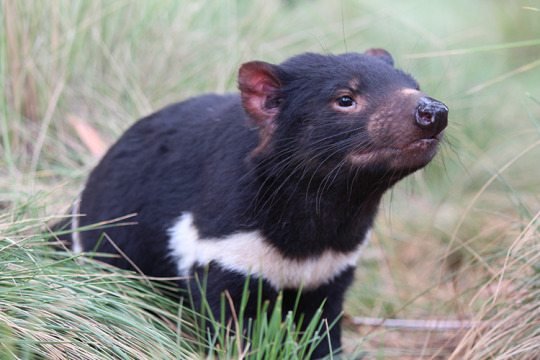
Thorny Devil
The second devil on our list is a glorious looking lizard also known as a thorny dragon. Thorny devils are great at camouflage in the desert and even have a false head to confuse predators. They can also absorb water through any part of their body.
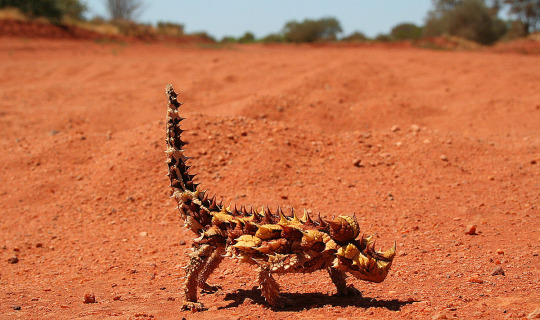
0 notes
Text
Every animal face-off in the BBC’s new nature documentary, rated
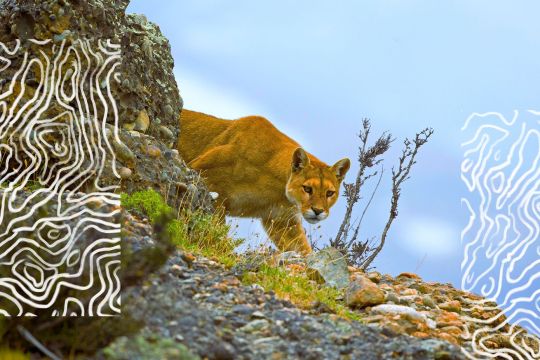
Sylvain CORDIER/Gamma-Rapho via Getty Images
David Attenborough’s new show is epic ... and sports.
We continue our extremely important mission to conduct a scene-by-scene review of the BBC’s new nature documentary, Seven Worlds, One Planet, in order to see how sports it is. We determined that Episode 1, which focused on Antarctica, was reasonably sports. Asia was very sports. Time for ...
Episode 3 South America
Scene 1: Puma vs. Guanaco
Feeding a family of three is hard, especially if you’re a single mother who is also a Patagonian puma. Mountain lions, the Americas’ second-largest cat, don’t get the reputation they deserve: their glory is stolen overseas by African lions and tigers and at home (at least in South America) by the jaguar. But all big cats are worth our attention, because they’re designed to kill you. Yes, you personally.
Possessing murderous grace, strength complimented by rending claws, surprising stamina and teeth optimized to clamp around one’s neck just so, a puma is a serious predator. And, perhaps unfortunately for Patagonian pumas, they hunt serious prey: guanacos. They’re built for the mountains, with the ability to breathe very thin air. They’re also built for puma attacks. Thick skin around their neck helps protect them from the fatal bite, and their height and heft — over three times that of a mountain lion — does too. A guanaco is not an easy hunt.
But hunt them mother puma must. There’s the family to think of, after all. So we’re treated to a series of puma-guanaco battles, closely matched and extremely well-fought, on scrub and in snow.
youtube
Over a bruising few days, the mother, injured from an earlier attempt, finally makes a kill, sprinting to catch her foe, wrestling it to the ground, suffocating it with a bite and then dragging it over a mile back to her territory. Sometimes you just have to play through pain.
Aesthetics 10/10
Everything about this scene is beautiful, from the shapely mountains that backdrop the hunts to the limpid pools enjoyed by the cougar cubs. And both animals featured are lovely, too — we’ve discussed the murderous beauty of the puma, but there’s an elegant majesty to the hunted guanaco too.
Also, this dude makes a brief appearance:

BBC Earth
This is a dirty look that almost transcends perfection. Well done, grumpy old man puma.
Difficulty 10/10
The puma’s kill was difficult enough without having to drag a corpse a mile across the Patagonia scrubland while injured. That’s some good mothering.
Competitiveness 10/10
Guanaco are pretty spectacular things, and they gave the mother puma almost more than she could handle. An incredible battle.
Overall 30/30
Running to rodeo to wrestling to, uh, dragging? We’ll call this the puma tetrathlon, and it is definitely sports.
Scene 2: Turd Penguins
The Pacific coast of South America is shaped by the Andes above and the Atacama Trench below, where the Nazca Plate subducts under the continent to fuel its belching volcanic spine. The trench, and the Humboldt Current which flows above it, drive nutrients into the surface waters offshore, which attract some of the world’s largest concentrations of seabirds. And, therefore, also the world’s largest concentrations of seabird poop.
Guano has an incredible history. Seabird manure is extremely good for fertilizer, but in most areas of the world, many of the nutrients are washed out by rain. On the Peruvian coast, however, it doesn’t rain, so high-quality guano collects. And collects. And collects. When Alexander van Humboldt, who gave his name to the current (as well as a particularly disgusting species of penguin, whom we will be discussing later), brought back news of the Peruvian deposits, he sparked a massive guano boom.
For years, guano mining was the foundation of the Peruvian economy. Control of guano islands was so important that wars were fought over it, and the United States’ push into the Pacific was at least partly due to the search for new, uninhabited guano sites. The use of guano across the world has even been blamed — how credibly I’m not well-equipped to assess — for the particular strand of blight that caused the Irish Potato Famine. Until synthetic fertilizers were produced in the early 20th Century, guano was vital for world agriculture. Now it’s where some very awful penguins dig their disgusting little nests, coating themselves in the process.
My friends would describe me as dirty, but cute #SevenWorldsOnePlanet pic.twitter.com/TrsLBX0Y7c
— BBC Earth (@BBCEarth) November 10, 2019
NB: If you watch the full episode, be prepared to watch a penguin take a dump. Consider yourself warned.
Turd penguins, like their less smelly cousins, need to get to the sea to eat. And this is a more challenging affair than usual during breeding season, as the rich waters off the coast attract more than seabirds. Blocking off the penguins’ access is a full colony of sea lions.
I like to imagine (probably definitely incorrectly) that these sea lions are normally fairly chill animals. But when your nice, quiet beach is invaded by a shrieking mob of penguins LITERALLY COATED BEAK TO TAIL IN SHIT, it’s hard to be chill. And when those penguins ignore your warnings to go the fuck back to whatever shithole they came from and instead CROWD SURF OVER YOU, it’s even harder.
When you go into a store and the shop assistants pounce #SevenWorldsOnePlanet #amistakehasbeenmade pic.twitter.com/bI8DfPdAcL
— BBC Earth (@BBCEarth) November 10, 2019
Actual footage of life throwing me curveballs #SevenWorldsOnePlanet #oopsiedaisy pic.twitter.com/h5dn54cu5G
— BBC Earth (@BBCEarth) November 10, 2019
Turd penguin don’t give a fuuuuuuck.
Aesthetics 2/10
I’m the father of two small children and so consider myself fairly immune to whatever horrors bodily fluids might attempt to inflict upon me. But this is enormously gross, and not even some sassy sea lions can rescue it.
Difficulty 9/10
Running through a pack of angry sea lions who desperately want you to go away and could kill you quite easily is one thing. Using them as a jungle gym is another. Don’t try this at home. Actually, don’t try any of this scene at home.
Competitiveness 10/10
Humboldt penguins weigh somewhere around 10 pounds. An adult male sea lion can be as much as 20 times as heavy. Being willing to barge your way through/over a wall of angry muscle and blubber like that takes some incredible bravery.
Overall 21/30
Surfing is a sport, even when it’s done by unbelievably dreadful birds. Goodbye, turd penguins. I hated you.
Scene 3: Nerd Bears
There’s nothing wrong with being a nerd. Some of my best friends are nerds, after all. So when I say that the spectacled bear is a nerdy-looking bear, it’s out of affection. And accuracy:

Photo by Blick/RDB/ullstein bild via Getty Images
Cool glasses, nerd.
The spectacled bear is only found in the cloud forests of the Andes, and is correspondingly rare and vulnerable to habitat loss. But, like millennials, who do things like watch the world burning around them and yet spend their time shitposting about nature documentaries rather than actually doing anything useful, these bears love avocados. Even when those avocados are 30 meters off the ground.
These nerds aren’t as heavy as the polar or brown bears we met in the Asia episode, but they’re still reasonably heavy, and the thin branches that the avocados grow on are nowhere near big enough to support them. So the smart bears just bite into the branches so that they dangle down low enough for them to reach. The less smart bears bite them off entirely and have to climb all the way back down. Most fast and break things. That’s the nerd way.
Aesthetics 7/10
I’m mostly giving this a good score because there aren’t any penguins in it. But also these bears have some pretty good vibes:
Me living my best life #SevenWorldsOnePlanet pic.twitter.com/WMreQHmzww
— BBC Earth (@BBCEarth) November 10, 2019
Difficulty 5/10
That’s a pretty big tree to climb, and a pretty big body with which to climb.
Competitiveness 7/10
In the battle of bear and bear, all it takes is a little bit of technique and know-how to get the upper paw.
Overall 19/30
On the surface, the avocado hunt is not exactly the stuff to stir one’s blood. But there’s an important, if unspoken rule about sport-assessing, of which I am now a professional: if you watch cheating, there’s a pretty good chance that it’s sports.
Scene 4: Look at this monkey’s hair!
youtube
These Cotton-top Tamarins are critically endangered, which is a big shame because they have cool hair. Their habitat is being destroyed for all the traditional reasons, and it’s depressing. You know the drill.
Aesthetics 10/10
Someone get me their stylist’s number ASAP. I can only assume Carlos Valderrama was inspired by these little dudes.
Difficulty 10/10
This was going to be a bunch of monkeys sitting around and looking cool while their home is being razed around them, like a primate version of the ‘This is Fine’ dog. And then one did an absurd tree jump, which would kill 100 percent of the humans that tried to match it.
Competition 0/10
Monkeys vs. praying mantis? No contest. Monkeys vs. the inexorable tide of ‘progress’ that is slowly grinding their entire species away. Also no contest.
Overall 20/30
If everyone doing long jumps at the Olympics had these haircuts they’d get way better sponsorships. Sports.
Scene 5: The Very Horny Bird Squad
Birdsong is one of the joys of spring, and it’s only improved by the knowledge that it’s a bunch of tiny dinosaurs loudly expressing their desperate need to make some babies. Cheep-cheep-sexnowplease-cheep. For many birds, mere song is not enough. Bright, ostentatious plumage is a sign that a male is healthy and thus that his courtship attempt is worth responding to. And sometimes, the female bird wants to see some dancing.
Bird courtship routines are a staple of natural history programming, but in the Amazon we’re treated something rather more curious: the Blue Manakin team dance.
youtube
The lead male bird somehow wrangles a squad of subordinates to help him do his *ahem* dirty work. Attenborough claims that “by supporting [the leader] now they may themselves eventually become leaders and get a chance to mate,” which sounds dubious to me. It’s basically a bird sex pyramid scheme, little buddies, so don’t fall for it. The leader’s out to screw you.
This scene is made much better by the fact that the female bird is completely uninterested.
Aesthetics 10/10
Beautiful birds, beautiful dance moves. I particularly love the synchronized shuffle-hop, but the final flap-your-wings-while-screaming routine might need some work (its target seemed to think so too).
Difficulty 8/10
I can’t even dance by myself, let alone in a group. How many hours of practice went into this routine?
Competition 7/10
This very good dance not being good enough strongly implies that there are other, more capable bird squads around.
Overall 25/30
Team dancing is sports, even if in this case it’s extremely horny sports.
Scene 6: Poison Dart Frogs
Living in the rainforest is a pretty good deal for poison dart frogs. It’s nice and damp, there are some great trees to hang out in, and since almost everything that touches you has an unpleasant experience they get a fairly stress-free time.
But there is a problem: standing water. With some deeply weird exceptions (don’t google the Suriname toad if you have trypophobia), amphibians need water in which to lay their eggs. There aren’t too many ponds to be had, up in the canopy. So they have to make use of the tiny pools of water that collect in bromeliads, one per egg. Sometimes they choose badly and the small pool in which the egg has been placed dried up before their tadpole has finished developing:
Blob fish or tadpole? You decide#SevenWorldsOnePlanet pic.twitter.com/DUr5hn8tbm
— BBC Earth (@BBCEarth) November 10, 2019
That tadpole is in trouble, and the only way to help is to get it to a real pool of water. That means relocation via piggyback ride, perhaps even to a new tree, and then a summoning of the tadpole’s mother to lay another (unfertilized) egg to serve as food. Yum yum.
Aesthetics 3/10
Poison dart frogs have bright and flashy coloring to warn predators not to eat them. These yellow-and-black ones are particularly smart-looking. But bright colors alone aren’t doing it for me.
Difficulty 6/10
When you’re less than an inch long, searching through the forest with a baby on your back for a new place to stash it must be very hard work. Remembering where exactly you’ve dumped all your children seems like a tough task too.
Competitiveness 2/10
I’m guessing that there are a bunch of other poison dart frogs looking for egg pools in this forest, so I guess they can have a couple points here.
Overall 10/30
Not sports.
Scene 7: Scarlet Macaws
Parrots jostle and fight for position on the banks of a particular stretch of the Amazon. Are they after food? Not exactly. Parrots’ diet is low in salt, and their chicks need salt to develop, and here, at the edge of the river, is salt-laden clay. So the parrots squabble to grab a chunk of mud, fly up to 50 miles (!) back to their nests, and feed it to their children.
Aesthetics 5/10
Scarlet macaws are pretty birds:
Nothing more romantic than a cheeky head scratch and a chest peck #SevenWorldsOnePlanet pic.twitter.com/kgea0ciCCg
— BBC Earth (@BBCEarth) November 10, 2019
And we get to see more than just them. There are plenty of blue-and-gold macaws (my favorites) battling it out for the mud too, plus a sizable squadron of what I think are probably Amazon parrots in their greens.
Difficulty 4/10
This is more annoying than difficult, apart from the very long distances the birds have to fly.
Competitiveness 3/10
If there was a real free-for-all this would have scored quite high, but there appear to be just enough rules in parrot society to keep the clay harvesting from descending into an all-out brawl.
Overall 12/30
Nope.
Scene 8: Un-diving
This is more like it. A thousand miles south of the parrot clay feast, a troop of brown capuchins is moving through the trees, looking for breakfast. Staring up at them, following their every move, are ... fish. The piraputanga are able to see the monkeys clearly because Bonito’s Rio da Prata is fed by freshwater springs, naturally filtered by the underlying rock.
Are these fish on the hunt for monkey meat? No. Like dogs following a toddler, they’re hoping for their scraps. When the monkeys find ripe fruit — impossible to spot from underwater — they stop and eat. Plenty drops into the river. But an anaconda soon interrupts breakfast, attempting to ambush the capuchins from underwater.
Fortunately, that’s not the end of the piraputangas’ meal. Now that they know where the fruit is, they have schemes of their own:
...Try, try again #SevenWorldsOnePlanet pic.twitter.com/WEGJHlB1sm
— BBC Earth (@BBCEarth) November 10, 2019
I have to admit that I did not see this one coming.
Aesthetics 9/10
This is a beautiful scene. While none of the animals themselves are that attractive, the environments, particularly the crystal-clear waters of the Rio da Prata, are sublime. The anaconda’s slither through the mud carries with it potent, barely-seen menace. And then there’s the piraputanga jump. They have surprisingly good form, for fish.
Difficulty 8/10
Trying to jump several times your body height to grab something you can only barely see would be tricky enough if you were able to use your hands. Now imagine you have to do that with your teeth.
Competition 8/10
These fish mean business, and there’s not enough fruit to go round. After the monkeys are done with their handouts, the highest and best jumper is literally the one which gets to eat. A bonus point for the anaconda hunt.
Overall 25/30
Diving is sports. Un-diving is also sports.
Scene 9: Waterfall Skimmers
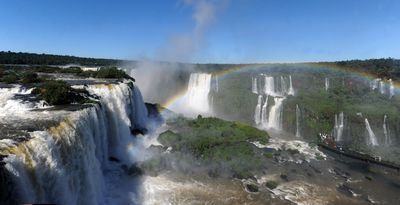
Norberto Duarte/AFP via Getty Images
Great dusky swifts will do a lot to protect their chicks. Harried and harassed by falcons, they have a perfect hiding spot for their nests: behind the thundering curtain of the Iguaçu Falls. The falls, on the border between Brazil and Argentina, are the biggest waterfall complex in the world, and the wet rock behind them is all that the chicks know before they take their first flight. Which is right through the pouring water and to the other side:
These great dusky swifts are able to fly right through the thundering torrents of water.#SevenWorldsOnePlanet pic.twitter.com/txtjP3mOFo
— BBC Earth (@BBCEarth) November 10, 2019
Birds nesting in challenging places gives their chicks a great chance in the earliest days but creates a terrible bottleneck later on. This trial by waterfall isn’t the worst thing nature does to baby birds, but it’s an impressive challenge to get past. Blind and bedraggled, these tiny, barely-fledged swifts have to force their way through the falls and out into the open air for the very first time. Their reward is some pretty damn good scenery, and probably getting eaten by a falcon or something.
(Bonus video!) Here is the worst thing that nature does to baby birds:
youtube
Aesthetics 10/10
Lovely. While great dusky swifts aren’t very pretty on their own, especially when wet and flummoxed, the Iguaçu Falls are one of the planet’s most spectacular sights, and watching these 8-inch birds take them on is unbelievably cool.
Difficulty 10/10
This is another thing that would definitely kill you if you attempted it. Well, all flying would, but especially this one.
Competition 9/10
Little birds vs. enormous waterfall is a David-and-Goliath sort of deal.
Overall 29/30
Extremely sports.
0 notes
Text
15 Photos That Will Make You Want To Visit Tanzania!
Travel Photography from Tanzania
Tanzania
Here’s a collection of my favorite photos from our safari trip in Tanzania. We managed to see all big five safari animals, hiked to a beautiful waterfall, and met with local tribes.
Last December Anna and I visited Tanzania for our honeymoon, heading out on safari with Soul Of Tanzania. We began our adventure from the town of Arusha, flying into the Serengeti in a small plane.
We spent a week bumping around on dusty read roads in a Land Rover exploring Africa’s Serengeti National Park, the Ngorongoro Conservation Area, Lake Manyara, and Lake Eyasi.
During the course of the trip we managed to locate all “Big Five” safari animals, journey through the savannah, into green forests, and past massive shallow lakes.
Tanzania’s wildlife and geography is as diverse as its people, and finally getting to visit the Serengeti itself was quite a treat, as it’s the world’s most famous National Park.
If you’ve ever dreamed about going on safari in Tanzania, these images should give you a glimpse of what the experience is like!
1: Lake Manyara Flamingos
Flamingos Take Flight Over Lake Manyara
Lake Manyara National Park lies on the edge of the Rift Valley, attracting thousands of pink flamingoes to its brackish waters. Surrounding the lake is a large grassy floodplain, and groundwater forests beyond that.
We stopped for lunch along some algae-streaked hot springs, with a boardwalk leading out over the lake. From there you could watch the huge flocks of flamingos stoop and graze in the water.
Occasionally, they’d all leap into the air and take flight together as a moving wall of pink and black feathers. It was quite a sight!
Did you know that flamingos are actually grey, and get their pink color from a diet of brine shrimp and blue-green algae? The alpha and beta carotenoids in the food they eat is what turns them pink.
2: Visiting The Maasai Mara
Sokoine Shows Us Around His Village
There are about 800,000 Maasai Mara living in Tanzania, many around the Ngorongoro Conservation Area. I’d always wanted to visit the Maasai, so we stopped by the village of Endyoi Nasiyi as we left the Serengeti.
Maintaining a traditional pastoral lifestyle has become increasingly difficult for the Maasai. With their cattle grazing lands diminishing, they’ve become dependent on purchasing food like sorghum, rice, potatoes and cabbage.
Tourist visits help provide the tribe with money to make these purchases. Each village (boma) has a few college-educated & English speaking members like Sokoine, who taught us about his culture.
These village trips can feel a little awkward, like everyone is putting on a show. And they are a bit. However it’s one of the only ways the Maasai can earn money while maintaining their traditional lifestyle.
3: Materuni Waterfall
Hiking to Materuni Waterfall
Outside the town of Moshi, along the slopes of Kilimanjaro, there’s a beautiful and imposing 150 meter high waterfall called Materuni located deep in the lush jungle.
Locals lead hikes to this magical place, usually in combination with a coffee tour. The waterfall hike takes about an hour. On the way we saw brightly colored chameleons and butterflies.
You can swim under these powerful falls — however be warned, the water is very cold! I jumped right in though, never one to turn down a refreshing wild-swim. It makes you feel alive!
After returning from Materuni waterfall, we learned how to make coffee from scratch with a group of Chagga boys, one of Tanzania’s largest ethnic groups.
We helped separate the husk from dried beans, roasted them on an open fire, and finally grinding into powder for brewing — all while singing to keep up a good rhythm. Probably the freshest cup of coffee I’ve ever tasted!
4: Kings Of Ngorongoro
Lions in Ngorongoro
One of the best places to see wildlife in Tanzania, aside from the Serengeti, is the Ngorongoro Crater. The crater is the result of a large volcano that exploded and collapsed into itself about two million years ago.
High crater walls protect a large variety of wildlife at the bottom, including a population of 70+ lions. Tanzania is actually home to about one third of the world’s remaining lions.
We got lucky stumbling onto a pride of 8 East African lions hanging out beside the road! We watched them from the top of our Land Rover — lounging in the sun, playing in the grass like big house cats.
Surprisingly a group of antelope was only 200 feet away, but it seemed these lions weren’t hungry. These were only a few of the lions we saw while visiting Tanzania, but were the closest.
5: Elephant Pool Party!
Elephants at the Four Seasons Pool
Because Anna and I were celebrating our honeymoon in Tanzania, we decided to stay in some nicer hotels. The one we were most looking forward to was The Four Seasons Serengeti. Why?
Well, apart from being a luxury safari lodge in the middle of the world’s most famous national park, the complex itself is almost always surrounded by animals!
You’ll see all kinds of wildlife during their game drives, but you might also spot waterbuck, monkeys, antelope, elephants, and even the occasional leopard while walking the property’s elevated walkways.
There’s a popular watering hole right beside the pool, which often attracts large groups of elephants passing by for a drink. Definitely one of the most unique hotel experiences we’ve ever had!
6: Africa’s Miniature Deer
A Cute Pair of Dik Diks
Standing just over a foot tall, the Dik Dik might just be the cutest safari animal you’ll find in Africa — and probably has the funniest name too. These tiny antelope have long noses and big doe-eyes too.
They travel in pairs instead of herds, and dik-diks mate for life. The males may have horns, but the females are larger and the ones in control of the relationship.
These guys are super fast! It was fun watching them dart off as our safari vehicle drove by. Dik-diks are gernally shy, hiding from others most of the time.
When startled, they take off in a series of zigzag leaps calling “zik-zik”, hence their funny name. They also mark territory using “tears” that come from that black spot in the corner of their eyes.
7: Lake Eyasi Sunset
Sunset over Tanzania’s Lake Eyasi
We spent a night along the shores of Lake Eyasi, a large salt lake in the fertile Great Rift Valley. Staying at Kisima Ngeda Tent Camp, it was possible to hike up to the cliffs overlooking the lake for a nice view of the region.
The landscape around Lake Eyasi feels very different than the hot, dry grasslands we’ve been traveling through up until that point. It’s wet and tropical, with large palm trees full of squawking birds.
Animal life isn’t as dense here, other than birds, but the reason most people visit is to meet with the local Hadza and Datoga tribes, curious to see their ancient hunting and blacksmithing abilities in person.
I climbed up to a high viewpoint in order to watch the sunset over the mostly-dry lake. During the wet season, it can actually get pretty deep and attracts groups of wading hippos cooling off in the salty water.
8: Hunting With The Hadzabe
Hadzabe Village near Lake Eyasi
The Hadza bushmen are one of the last true hunter-gatherer tribes left in the world. About 800 of them live semi-nomadically in the dry woodlands of remote Lake Eyasi — surviving on wild game, berries, and root vegetables.
We got up early one morning to visit a Hadza encampment, learn a little about their culture, and tagged along as they went hunting for small birds and antelope using hand-made bows and poison-tipped arrows.
The story of the Hadza is fascinating but sad. Basically their land has slowly been stripped away from them by commercial agriculture, the government, and wealthy Arab animal trophy hunters.
Their traditional way of life, which hadn’t changed much in thousands of years, is under threat. Like the Maasai, some have turned to tourism to support their families with limited other options available. Efforts to settle them in more modern farming communities have largely failed.
9: Dirty, Dirty Hippopotami
Africa’s Most Dangerous Animal
Anna’s favorite African animal is the hippo, so there was no way we were going to miss them on this trip! Luckily she got her fill of these massive dirty water pigs in the Serengeti and at Lake Manyara.
Ok, maybe they aren’t technically pigs. But they do have a habit of belching, snorting, and loudly shooting explosive diarrhea out their backsides… not MY favorite animal.
The hippopotamus is also Africa’s most dangerous animal, if you can believe that. They kill an estimated 500 people every year. They are extremely territorial, and much faster than they look!
I went kayaking with them in South Africa once, and it was a little unnerving to be so close. While it’s fun to watch them play in the water and splatter poo everywhere, you should always stay aware of your surroundings.
10: Leopards Of Tanzania
Baby Leopard Making Faces
The one animal I was most looking forward to seeing in Tanzania on safari was the leopard. Locating them can be a bit tricky sometimes, which is why it’s known as Africa’s most elusive big cat.
Luckily we were traveling through the Serengeti’s Seronera River Valley, one of the best places to find them in the wild. We eventually witnessed four different individuals perched in yellow-barked acacia trees.
However my favorite sighting was at Lake Manyara National Park while driving down one of the bumpy dirt roads. A baby leopard suddenly appeared just on the edge of the brush, about 50 feet away.
The cat briefly hesitated as we approached, then disappeared back into the trees. But not before I snapped the photo above. We continued searching for his mom, but never found her.
11: The Datoga Tribe
Narajah’s Beautiful Jewelry & Tattoos
Also living within the Rift Valley is the Datoga people. Originating from the Ethiopian highlands 3000 years ago, this ancient tribe moved South into what’s now Kenya and Tanzania.
The Datoga are expert blacksmiths — forging arrowheads, bracelets, and knives out of aluminum and brass over open fires. They trade these products with their Hadza neighbors in exchange for meat, honey, and animal hides.
We stopped in to visit with Narajah (pictured above) and learn a little bit more about her family and culture. Narajah is just one of her husband’s 7 wives. Each has her own house for raising their children.
Apparently Narajah’s husband gave her 10 cows as a marriage gift. When she asked Anna how many cows I offered, she wasn’t very impressed to learn all she got was a cat! Apparently I’m cheap…
A common body modification among women in the tribe is the tatooing of circular patterns around the eyes. It helps identify who belongs to a certain family and, to the Datoga ethnic group.
12: Magic Baobab Trees
Massive Baobab Tree
Finally! My first Baobab tree. I’d heard of these ancient giants for years, and didn’t even realize any grew in Tanzania. I thought the only place you could find them was Madagascar…
There are actually 8 species of baobab around the world. The largest is Adansonia digitata, which grows up to 30m tall in Tanzania. I think baobabs have to be the most iconic trees in Africa.
The trees vary in size depending on the season, as they can hold up to 100,000 liters of water within their trunks.
Hollowed out trunks of the baobab trees are often used as shelter by Hadza Bushmen, especially when it rains. Some trees can accommodate up to 30 people inside!
13: Angry Blue Monkeys
Blue Monkey Screaming in the Trees
Blue monkeys are not really blue, more of an olive or grey color. They live largely in the forest canopy, eating fruits, figs, insects, leaves, twigs, and flowers.
We came across a group in the trees on the edges of Lake Manyara National Park, calling out to each other. Some families can be composed of up to 40 individuals, mostly female, with one male leader of the group.
Other monkeys was saw on safari in Tanzania include vervet monkeys, baboons, and the black-and-white colobus.
Look at those teeth! I wouldn’t want to get too close — even if they do prefer eating fruit.
14: Buffalo VS. Land Rover
Buffalo Encounter at Lake Manyara
I love this shot at Lake Manyara. An old Cape Buffalo stands off against a Land Rover, each waiting for the other to make a move.
Buffalo are very successful in Africa because they aren’t picky eaters. We saw hundreds of them during a week of safari drives through Tanzania. Munching away at the grasses, or rolling around in the mud.
However they can become aggressive towards vehicles, charging them if they feel threatened. They have also been known to gore hunters (good for them!) after being wounded.
Buffalo herds stick together, and when attacked by predators, will sometimes return to save one of their own. They’re not afraid of fighting lions either, or killing lion cubs as a preventative measure!
15: Endangered Black Rhino
Lone Black Rhino in the Distance
The last of the big five animals we wanted to see in Tanzania was found in Ngorongoro Crater. The black rhinoceros is critically endangered, with only about 5500 left in the world.
Ngorongoro is home to about 26 of them, and because they are on top of everyone’s list to see, safari guides coordinate with each other over radio for news of recent sightings.
While we weren’t able to get very close (vehicles in the crater aren’t allowed to drive off-road), we did manage to spot a single rhino walking in the distance.
The poaching these animals for their horns is still a problem, however it’s been reduced over the past few years due to improved conservation efforts & security.
Tanzania Safari Travel Tips
The safari tour we booked was through Soul Of Tanzania. We had an amazing time! The jeeps are very comfortable with big windows, wifi, and plugs to charge your electronics.
Our guide Huruma was very friendly, knowledgeable, stopped frequently for photos, and was plenty cautious with the animals.
WHEN TO GO – Tanzania’s primary rainy season is during March, April and May. The famous Great Migration happens during the dry season, between July and early October. We were there in December, during the “mini” wet season. No matter when you go, you’ll see tons of animals.
COSTS – Going on safari in Tanzania isn’t cheap, however there are options for different budgets. National Park fees alone can cost $70 a day. While self-driving is technically possible, it’s incredibly complex to arrange, and often just expensive as a tour.
BUGS – Beware the Tsetse flies, they suck! Literally. These painful and annoying flies are attracted to dark colors – especially blue and black. This is the reason everyone on safari wears white or tan clothing!
PHOTOGRAPHY – If there’s one place where you’ll want to splurge on a zoom camera lens, it’s on safari in Africa. I’d recommend something at least 200mm, but 400mm is even better. I rented a huge 400mm lens from LensRentals.com (and highly recommend them). ★
Pin This!

Any questions about going on safari in Tanzania? Are you planning a trip? Drop me a message in the comments below!

This is a post from The Expert Vagabond adventure blog.
from Tips For Traveling https://expertvagabond.com/tanzania-safari-photos/
0 notes